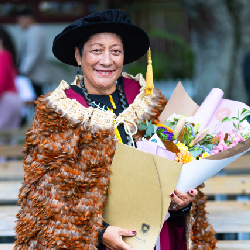
Kahutoi Te Kanawa
Ngāti Maniapoto, Waikato-Tainui, Ngāti Kinohaku, Ngāti Tūwharetoa, Ngāti Rora, Ngāti Apakura, Uekaha
Kahutoi She is co-director of a new textile research centre at Auckland museum, Te Aho Mutunga Kore.

Under a blue autumn sky, the kahu kura (cloak) made of red kākā (native parrot) feathers floated gently on Kahutoi Te Kanawa’s shoulders as she made her way onto Te Kohinga Mārama marae on Monday afternoon.
A highly acclaimed textile artist and weaver, museum curator and teacher, Kahutoi was graduating with a Doctor of Philosophy (PhD) degree in Tikanga Māori Creative Practice from the University of Waikato.
It was a moment that acknowledged years of hard work, and the tūpuna (ancestors) who came before her, helping guide her on her journey.
The kahu kura she was wearing was a treasured garment made by Kahutoi’s mother, Diggeress Rangituatahi Te Kanawa, for her father, Tana Te Kanawa, and usually resides in Waikato Museum.
Whānau of weavers
Of Ngāti Maniapoto, Waikato-Tainui, Ngāti Kinohaku, Ngāti Tūwharetoa, Ngāti Rora, Ngāti Apakura, Uekaha descent, Kahutoi is from a long line of tohunga kairaranga (master weavers).
Her work is exhibited around New Zealand and the world, and she currently works as Pou Ārahi Curator Māori at Auckland Museum.
Her PhD thesis, Taonga tuku iho: Intergenerational transfer of raranga and whatu, focused on the importance of Indigenous knowledge and practice, and how that knowledge is transferred between the generations.
Hailing from Te Kūiti, Kahutoi grew up learning the art and craft of weaving alongside her mother and grandmother, developing a lifelong passion for mahi harakeke (working with flax), raranga (weaving) and whatu (muka fibre) weaving.
My earliest memories are watching my mum and nan, and listening to them, and the kōrero and banter that went on while they were weaving.
Her mother Diggeress Te Kanawa was one of New Zealand’s most renowned weavers, and her grandmother, Dame Rangimārie Hetet, was also an award-winning and revered weaver and artist.
Both were acknowledged with honorary doctorates by the University.
“Their weaving, it was so refined,” says Kahutoi.
Doctoral journey
Kahutoi has a long history as an educator and artist, teaching at the University of Otago, Te Wānanga O Aotearoa and at Waikato University.
She initially started her PhD in 2012 at AUT, but it “became untenable” as she was travelling regularly between Te Kūiti and Auckland, torn between family and study commitments.
In 2016, she enrolled to study at Te Pua Wānanga ki te Ao – Faculty of Māori and Indigenous Studies, effectively starting her PhD again from scratch at Waikato.
It was the right move for her. The Hamilton campus was closer to home, and there were already strong connections through her mother, grandmother and being Waikato-Tainui.
Kahutoi received great support from her PhD supervisors Professor Leonie Pihama (chief supervisor) and Dr Manulani Aluli-Meyer (from the University of Hawai’i). Professor Linda Tuhiwai Smith was another key supporter.
They were always amazing, so encouraging. They always guided me and helped me focus.
Kahutoi also received the University of Waikato Doctoral Scholarship, which provided financial support for three years.
Research inspiration
Her PhD research was inspired by a pukoro kete (tutu berry bag) that she first saw at the Otago Museum in Dunedin in 2007.
“It was really old and holey and ruined but what intrigued me is the way it was woven, and I knew instinctively that there was something different about this kete pukoro,” says Kahutoi of the beautifully woven red bag, constructed by an accomplished weaver.
Intrigued, she wanted to focus her research on the intergenerational knowledge transfer among Māori weavers, and the difference between theoretical practice and applied practice, and knowing and knowledge.
“The value of knowing is about having observable knowledge, the kōrero, the stories that go with what you are making [and] what’s it about,” says Kahutoi.
Knowing is identifying the thickness of materials by feel, knowing is also about seeing the difference in measurement – you see it and feel it – the smells, the environment in which the materials are grown and the protocols involved.
As part of her Creative Practice PhD, Kahutoi created a number of artworks including kete, whāriki and a pukoro as the centrepiece - all exhibited as Te Ohongo Ake in the Te Awamutu Museum in 2019 and 2020.
Dream job
Today, Kahutoi is enjoying her busy job working at Auckland Museum.
Her days are spent working on various projects and gallery renewals, immersed in many of Aotearoa’s most precious artefacts and cultural taonga.
She is co-director of a new textile research centre at the museum, Te Aho Mutunga Kore.
She is also part of a group working on Te Toki-a-Tapiri, a waka taua (war canoe), doing refurbishing and rebinding work with muka (flax fibre).
Another pipeline project Kahutoi is involved with is Ata Tiaki Taonga Tuku Iho.
It is teaching our people how to learn to look after our taonga.
It’s a dream job – combining her love of art, tikanga and education – and there is nowhere else she’d rather be.

